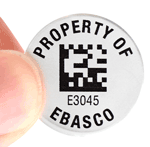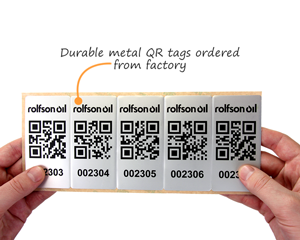Headstones with QR codes drag cemeteries into the digital age – including Arlington?
They might not yet rank as a full-fledged trend, but QR-coded ID tags are showing up in cemeteries, linking both the bereaved and the curious to online photos, obituaries, and video and audio memorials to the departed.
Whether etched with lasers directly onto the headstone, or tattooed onto a metal or ceramic plaque that is then attached to the stone, headstones with QR codes enable anyone with a smart phone to gain access to information about the deceased. For the past few years, they have found favor among forward-thinking technophiles in the cemetery and headstone industries, as well as grieving families.
A number of companies have jumped into this market. Some, like Seattle-based Quiring Monuments, create traditional headstones etched with QR codes that link to websites similar to Facebook, where families can post photos, obituaries and comments; anyone with a smart phone can read about the deceased but only authorized family members can add posts. (Quiring also sells QR-coded tags that can be attached to existing headstones.) Other companies, like Memphis, Tennessee-based QR Tag Memorial, offer online memorial sites and coordinating QR-coded tags that can be affixed to headstones or placed nearby.

Many manufacturers now offer headstones featuring QR codes, which take users to online memorials or obituaries. From Jason Eppink.
But not everyone thinks headstones with QR codes are a good idea. When The Washington Post published an article on the Arlington National Cemetery’s advisory commission’s deliberations on QR-tagged headstones, several readers chimed in to voice their disgust, contending that technology has no place in a cemetery, and that a mobile-phone-crazed public can’t be counted on to observe proper decorum in a cemetery. Others, though, in that article and elsewhere, applauded the idea, noting that QR codes can bring comfort to families grieving for their loved ones.
At its meeting on November 18, Arlington’s advisory commission directed the cemetery’s staff to prepare recommendations on whether and how to allow digital tools to be used n the national cemetery. The report is due next spring. It’s interesting to note that Arlington has been the center of a controversy between cemetery officials and families of recently interred service members. These families have, according to The Washington Post, been depositing all sorts of remembrances at their loved ones’ gravesites, everything from photos to football helmets, liquor bottles to holiday lights. In that light, QR tags might offer a way for bereaved families to personalize their loved ones’ graves without disturbing the solemnity of the national cemetery.
Maybe it’s all in how the QR-coded online memorializing is done. In North Wales, an organization called HistoryPoints.org has been tagging historic buildings, cemeteries and other points of interest with links to what its website describes as “instant snippet[s] of history.” The non-profit group calls its tagged sites HiPoints, and labels them with two QR codes: the first doesn’t require an Internet connection and delivers a quick bit of information; the second requires an online connection and brings the user a more detailed account of the site. If the user can’t connect to the Internet, the URL can be saved and visited later. The historical anecdotes appear as online text and many come with audio files.

A debate has begun over whether to permit QR codes on headstones at Arlington National Cemetery, one of America’s most hallowed memorials. From Fovea Centralis.
One HiPoint code posted in the cemetery outside St. Margaret’s Church in Bodelwyddan, Denbighshire, commemorates some 80 Canadian servicemen and women who died there in the aftermath of World War I. Visitors who scan this QR code learn the sad tale of the more than 17,000 military personnel stationed nearby after their service in France. While awaiting transport back to Canada, many succumbed to the European influenza epidemic of 1918-19 and never made it home.
Another very different HiPoint code marks a spot outside St. Mary’s Church in Conwy that is believed to have been the inspiration for William Wordsworth’s 1798 poem, “We Are Seven.” A scan of the QR code there recounts how tourists subsequently broke off pieces of the headstone until, when only a small piece remained, it was encased in a protective cage. The QR link offers an audio version of the poem for visitors to listen to.
QR-coded ID tags like the ones posted by HistoryPoints.org — not to mention those created for contemporary gravesites by tech-savvy, grieving families — are changing the experience of visiting a cemetery. They might not be a full-fledged trend just yet, but is there any doubt that they will be soon?
Category: QR codes














